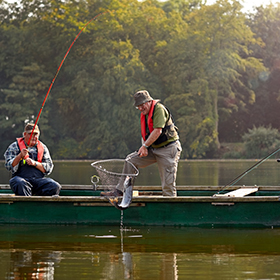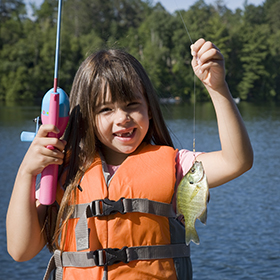Is your drag grinding? Fishing line fraying? You might need some new fishing gear. Learn 7 of the key signs that it could be time to visit a tackle shop!
There comes a time in every angler's life when they have to part with several pieces of beloved fishing gear. Make no mistake about it; the tackle purging process can be a very bittersweet experience. On one hand, you are ecstatic about the thought of buying new gear that has been constructed with the latest technological advancements and materials. On the other hand, tears start rolling down your cheeks at the thought of saying "goodbye" to the fishing reel that helped you land your first 8-pound bass -- even though you can't get the handle to turn an inch.
How do you know when it's time to retire certain types of fishing gear? Well, there isn't an all-inclusive answer to this question, but you can pinpoint key signs that it might be time to repair or upgrade based on the different types of fishing gear and components.
1. Your fishing reel starts to grind and the drag is no longer smooth. Try thoroughly cleaning and lubricating the reel based on the instructions in the owner's manual to see if it helps. If not, you may need to invest in a new fishing reel.
2. A fish hits your lure or bait and your line breaks as it's running through the rod guides. The inside of one of your rod guides may be scratched or chipped. Most rod guides are made with ceramic rings on the inside that can scratch or chip. If you run a nylon stocking through your rod guides and it catches, it's time to replace the guides (consider titanium guides that will last longer and won't corrode) or get a new rod.
3. You notice that your monofilament fishing line has kinks or abrasions in it. If you think that your monofilament has more memory than it used to or that it isn't as easy to cast, change it out.
4. Your braided fishing line no longer has a smooth texture and shows signs of fraying. Frequent use, wind knots, and rough structure can weaken braided fishing line. Again, when in doubt, change it out.
5. Your fishing hooks are rusty. If your hooks have just a few spots of surface rust, you may be able to file it off. However, a coat of rust can weaken the steel so it might be time to buy a few new packages of fishing hooks. To prevent rust from forming on your new hooks, rinse your hooks with freshwater after each use and allow them to dry off thoroughly before placing them back into your tackle box.
6. You can't open your pliers. Carbon-steel fishing pliers can corrode if they are not cleaned properly after use. If plan to take your pliers on saltwater fishing trips, it's very wise to invest in a corrosion-resistant aluminum, ¬stainless steel or titanium pair of pliers.
7. Your tackle trays are lined with melted soft plastic baits or spinner skirts. You should be able to scrape out the melted plastic and save the trays, but you will definitely need new soft baits. You may want to buy a lure wallet or use a soft tackle bag so that you can store your lures in separate compartments.
Now that you know about some of the signs that might point you in the direction of a nearby tackle shop, don’t forget to also get your fishing license.
How do you know when it's time to retire certain types of fishing gear? Well, there isn't an all-inclusive answer to this question, but you can pinpoint key signs that it might be time to repair or upgrade based on the different types of fishing gear and components.
1. Your fishing reel starts to grind and the drag is no longer smooth. Try thoroughly cleaning and lubricating the reel based on the instructions in the owner's manual to see if it helps. If not, you may need to invest in a new fishing reel.
2. A fish hits your lure or bait and your line breaks as it's running through the rod guides. The inside of one of your rod guides may be scratched or chipped. Most rod guides are made with ceramic rings on the inside that can scratch or chip. If you run a nylon stocking through your rod guides and it catches, it's time to replace the guides (consider titanium guides that will last longer and won't corrode) or get a new rod.
3. You notice that your monofilament fishing line has kinks or abrasions in it. If you think that your monofilament has more memory than it used to or that it isn't as easy to cast, change it out.
4. Your braided fishing line no longer has a smooth texture and shows signs of fraying. Frequent use, wind knots, and rough structure can weaken braided fishing line. Again, when in doubt, change it out.
5. Your fishing hooks are rusty. If your hooks have just a few spots of surface rust, you may be able to file it off. However, a coat of rust can weaken the steel so it might be time to buy a few new packages of fishing hooks. To prevent rust from forming on your new hooks, rinse your hooks with freshwater after each use and allow them to dry off thoroughly before placing them back into your tackle box.
6. You can't open your pliers. Carbon-steel fishing pliers can corrode if they are not cleaned properly after use. If plan to take your pliers on saltwater fishing trips, it's very wise to invest in a corrosion-resistant aluminum, ¬stainless steel or titanium pair of pliers.
7. Your tackle trays are lined with melted soft plastic baits or spinner skirts. You should be able to scrape out the melted plastic and save the trays, but you will definitely need new soft baits. You may want to buy a lure wallet or use a soft tackle bag so that you can store your lures in separate compartments.
Now that you know about some of the signs that might point you in the direction of a nearby tackle shop, don’t forget to also get your fishing license.









